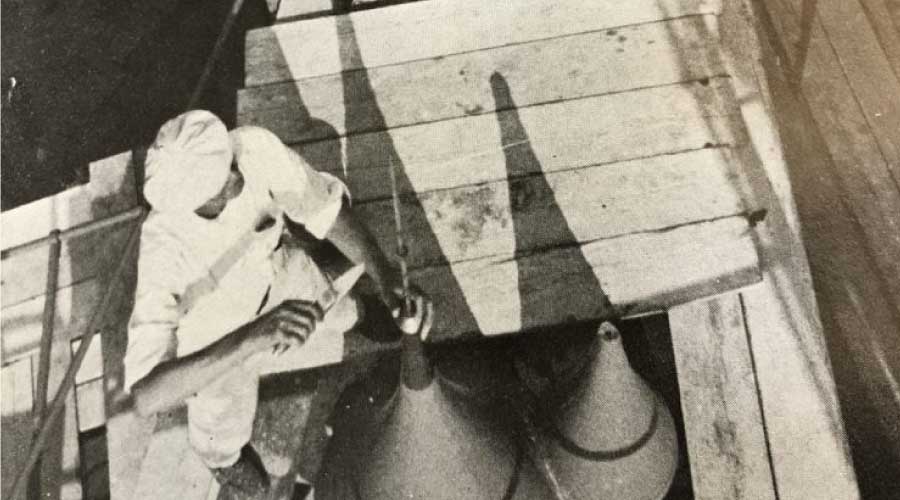5 minutes with Frank Lucas Assistant Director, Work Management University of Nevada, Las Vegas
Frank Lucas
Assistant Director, Work Management
University of Nevada, Las Vegas
When was the last time your organization purchased or upgraded its computerized maintenance management system (CMMS)?
March 2002.
What were the main goals of this purchase or upgrade? Were you able to achieve those goals?
We had outgrown the current CMMS and were looking for one that was more flexible, could handle increasing workloads for many years to come, and took advantage of emerging technologies. These became critical issues, due to the tremendous growth we were experiencing and changing missions both as a University and a department.
We also wanted a system that closely resembled the business processes we had established and could change as our business needs changed. We were able to find and implement such a system within our budget constraints and the time frame we had established.
Is your CMMS web-based? If so, how does this feature benefit your organization?
No, it is not web-based. But it contains some web-based features that we take advantage of, such as a request module that uses the customer's internet browser. We prefer to store and manage our own data because it lends itself better to client-initiated customizations and allows us to more easily link to other applications or trigger other actions.
What other software features should managers consider when specifying a CMMS?
What has always been most important to me is the ability to get information out of the system in a variety of ways. This is my sixth CMMS, and one thing vendors always push as a selling point is the number of canned or pre-formatted reports contained in their system. I seldom use these because they either are not formatted the way I want or do not offer enough filtering so I can get to just the information I need.
So what I really look for are things such as access to the back-end tables and the ability to write custom reports and queries using any commercially available report generator. Some packages even have their own ad hoc report writer and will allow you to export data into other formats, such as Excel or Word.
You never know what you're going to need out of the system, so the ability to do this should be a prerequisite for anyone interested in making such a purchase.
I also stay focused on what a CMMS initially is intended to do, which is manage maintenance activities. Many CMMS applications have become enterprise-based, meaning they have modules and features that will allow you to run all the needed business functions of an entire organization from a single piece of software. While these options are desirable, they should never be offered at the expense of maintenance management.
For example, financial systems are great for number crunching but not so good when adapted to manage maintenance activities and vice-versa. My advice is to not let the added bells and whistles distract you from why you're purchasing a CMMS in the first place.
What should managers look for when considering a CMMS vendor?
You should definitely get references from those who already own the software, but be selective. Indications are that most institutions only use 25 percent of a CMMS's full capabilities, so find a client that is using the features you are most interested in. Find out what they like and dislike, ask them about how supportive the vendor is when issues arise and how receptive the vendor is to change suggestions.
A good CMMS vendor will allow their customer base to help drive the direction of the software for future releases. After all, the client is in a much better position to know what their immediate needs are and where changes in the industry are likely to occur.
Another issue to explore is the implementation process. Did the clients do it themselves, or did they hire the vendor to do it? How well did it go? How long did it take? Did it satisfy your needs? Most failed applications are the result of poor implementation.
I don't care how expert an organization's information technology (IT) staff is. Nobody knows the product better than the vendor, especially when it comes to the unique issues at each institution that tend to govern how the maintenance organization behaves. I have always believed the vendor should be heavily involved in the implementation. That way, they can be held accountable for personnel training and proper operation of the system well after they've left the premises.
I also would collect some background information on the vendor. How long has it been in business? What is the history of the product line? Is it solely focused on maintenance management, or does it have other interests?
You need to remember that many such companies start in basements and garages, and most never get beyond that. Many others are corporate-owned entities, meaning their umbrella organization could abandon them at anytime should profits wane, interests change, or shareholders not be satisfied. This happened with one CMMS vendor I did business with - there one day, gone the next.
My advice is to determine how committed the vendor is to CMMS development and ask about long-range plans for the product and company.
What trends do you see regarding CMMS technology?
There is a major push towards web-based CMMS solutions. These are still behind the functionality curve, compared to desktop solutions but are gaining ground fast. Of course, their big advantage is being able to access the application using any browser anywhere in the world. Eventually, they also will make integration between application and hand-held device much more seamless.
The creation of more module options is also worth mentioning. Our goal is to make the CMMS our central operating and documentation system. As new needs emerge, we would rather purchase an add-on module than a new application, and the development of additional modules and features by vendors makes this possible.
These can include but are not limited to custodial services, purchasing card purchases and reconciliations, asset disposal, fleet management, computer aided facilities management, room inspection, keys and access card management, and utility management. By keeping information in one core database, we help insure data reliability and accuracy when crosscutting the facts and figures that make up our organizational profile.
The industry also is attacking a more complex issue involving facility condition inspections. Currently, most institutions use one or more applications to accomplish this task, including a CMMS. Some vendors are taking on this challenge, and I anticipate it won't be too much longer before you'll start seeing CMMS modules that fulfill this need.
If you were to purchase or upgrade a CMMS today, what would you do differently from the last time?
Many vendors offer free admittance to their annual user conferences prior to purchase. We didn't take advantage of this, but it is a great mechanism for seeing demonstrations of various modules and functions, gaining hands-on experience with the product in a demo lab, meeting company officials, asking questions, and seeing what the vendor is working on for future releases.
These conferences also offer a rare opportunity to network with hundreds of actual system users to determine their likes and dislikes, gain insights on their implementation processes, and discover potential pitfalls.
One of the keys we did focus on was the on-site demo each vendor performed. So many demos had features that just didn't work, which we feel is a red flag. A vendor should be able to demo any feature being offered and it should function properly without excuse. It also says something about the vendors - how well prepared they are, and how serious they are about gaining us as a customer. The demo not only shows off the product but also can be an indicator of things to come.
Something many clients don't think to ask about is whether certain features are included in the core application or must be purchased separately. Vendors will answer truthfully that their products will perform most functions they are asked about, only for the customer to discover that an add-on actually is required to gain the functionality. This also makes it difficult to compare prices. Buyers should spend some time leveling the playing field for all systems being considered so managers can make accurate comparisons before making a decision.
Does your department use hand-held devices, such as personal digital assistants (PDAs)?
We have just begun to do this in our warehouse operation. We are converting existing part codes to UPC codes to help eliminate confusion and take advantage of a unique worldwide numbering system that exists. Using a PDA with a bar-code reader, we'll be able to scan the product UPC during the receiving process and automatically update quantities and prices. We'll also be able to post parts and materials to bar-coded work orders in the same manner, as well as electronically request quotes and estimates from vendors using one product number.
The big push in the industry right now is toward a paperless work order environment. We deliberately have resisted making such a change at this time for several reasons.
First, what do we buy? The portable device industry is very dynamic, so much so that it's become increasingly difficult to determine which is the best option. Cell phones and PDAs are great but are limited in functionality and might not emulate the CMMS easily on such a small screen.
Portable laptops work well, especially in a wireless environment, but are still too large, bulky and expensive for the average technician to carry around. There are also issues with reliability, durability and obsolescence, to name a few.
Second, what are the costs? We have nearly 300 technicians, grounds workers and custodial staff members. While we probably wouldn't outfit all of them with an electronic device, it is still an expensive proposition. There is also the cost of interface software, protective cases, attachments and peripherals, cradles, administrative expenses, and other expenses, including replacing lost or broken units. We can generate a great deal of paper and hire more workers for the additional costs such a system is likely to generate.
Finally, there is the perception that moving to handheld devices will solve a lot of problems. Many new CMMS users jump into the handheld world almost immediately after implementation. We have spent the past five years developing and modifying our processes and procedures so they are as accurate and functional as possible. No handheld device will overcome a lack of preparation in this area and might even add to the confusion.
What advice do you have for managers considering handheld devices?
If it doesn't work on paper, it probably won't work in an electronic environment, either. I would advise taking time to do a detailed cost/benefit analysis, develop sound procedures and workflow processes, and determine the viability of products in the marketplace so a proper decision can be made as to whether or not to invest in a handheld solution.
Has your organization updated its facilities to incorporate wireless technology? If so, what was your in those updates?
This effort is under way, and we're seeing wireless capability in more facilities each week. It also has become a standard for all new facilities we construct or renovate. This was an initiative that was spearheaded by the university's executive management and is being carried out by our IT department.
Facilities Management is playing an active role on committees to select cell phone and network vendors, insuring our needs are being addressed. We also are discussing the subject of handheld devices for work orders and GPS locators.
How has the internet changed the way you specify products or select suppliers?
Like many institutions, we have taken advantage of just-in-time (JIT) contracts, electronic catalogs, and purchasing cards for making purchases. This has created cost and time savings, while offering more choice and convenience.
We've been able to submit for quotes and cost estimates much more easily by developing one specification and electronically sending it to multiple vendors at once. We've also been able to do product comparisons onscreen, visually match up a part, or cross-reference a number. Quite honestly, it would be hard to deal with a vendor in this day and age that doesn't do business in this manner.
What other electronic technologies has your department implemented in recent years?
The web-request browser has been a big addition that our customers enjoy using. We added a PowerPoint presentation showing how to use the system, along with traditional written instructions. In addition to being easy to use, the system sends receipt confirmations and status change e-mails of their request through completion. The customer also can use the system to query specific requests and work orders and view accumulated costs.
We have added more links to our web site to help customers find information faster. We've also included an interactive campus map. A number of forms have been made electronic and can be completed right on the screen.
We also use the web to get messages out to the campus in the areas of recycling, energy management and conservation, available services, vehicle rentals, rates, new facilities under construction, and project submittals, to name a few.
We also added a new web-based module on facilities condition assessments that contains inspection information on facilities across all campuses statewide. A batch file has been added to all PC start-up routines that compares the clients version of the CMMS to the current version on the server. As our CMMS vendor pushes out revisions or updates, we modify the batch file with the new release so users receive it automatically the following business day. This saves having to physically touch over 100 PCs every time a change is made.
How have these technologies benefited your organization?
The obvious answers are speed and efficiency, as well as freeing up labor resources we can allocate to other needs. But I cannot overstate the amount of good will this has generated with our customers. Not only do they perceive an improvement in service by being more responsive to their needs. It also improves their perceptions of us as a professional organization.
What e-technologies does your department hope to implement in the future?
A number of changes are underway that will be made available very soon. We've nearly completed developing a leave manager application that works with our collected CMMS time data designed to calculate accrued and used leave balances, as well as to forecast future balances by playing "what if" scenarios.
Employees also will be able to view their current leave balances and leave histories from any PC. We also plan on using collected time data to electronically prepare and transfer the payroll submittal. A number of hard-copy forms and manual processes will be converted to an electronic workflow system with digital signature. Information from these forms will automatically populate appropriate fields inside the CMMS once the form has completed an electronic approval routing process.
We also are developing an electronic key request application that seeks to mimic the manual signature authorization card comparison methodology, a standard process at many institutions. Other employee-identifier filters will be added to this process to enhance security.
Manual billing processes will become electronic, pulling information from the CMMS and transferring it into our financial package. Charge details will be available to customers on the web using a report application that can be scheduled to automatically generate and post each line item and their associated costs on a routine frequency.
Another initiative involves developing an electronic methodology for pulling in utility readings and cost data to facilitate needs forecasting, budgeting, and statistical analysis.
Finally, we hope to implement a GIS system that will contain the campus footprint, as well as all facilities, utilities, emergency phones, and other information points.
Do you hope to implement other e-technologies that will affect other building occupants, e.g. broadening areas with wireless access?
Since leave management is a manual process all across the campus at present, we anticipate our new electronic module eventually could be adapted to meet the needs of other departments. Also, the combination of our warehouse and electronic=billing initiatives will allow us to efficiently sell parts and materials to others over the web.
Our Campus Life Maintenance Department counterparts recently became users of our CMMS, and we anticipate being able to offer students and dorm managers their own web module for making maintenance and service call requests.
There is also a campus-wide initiative to address and resolve common data set inconsistencies between major unlinked electronic systems, develop common identifiers, and store them in one centralized system.
Other systems, such as our CMMS, would compare its static information to that of the centralized system and flag inconsistencies so changes can be made accordingly. This will help insure that consistent information is used throughout the campus.
Related Topics:











